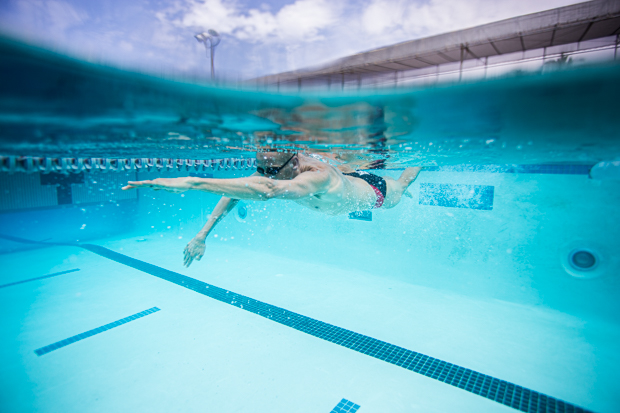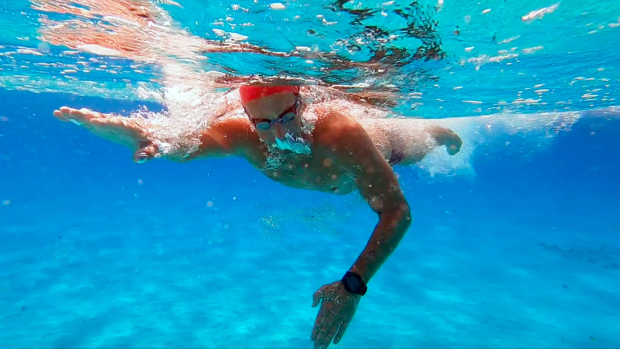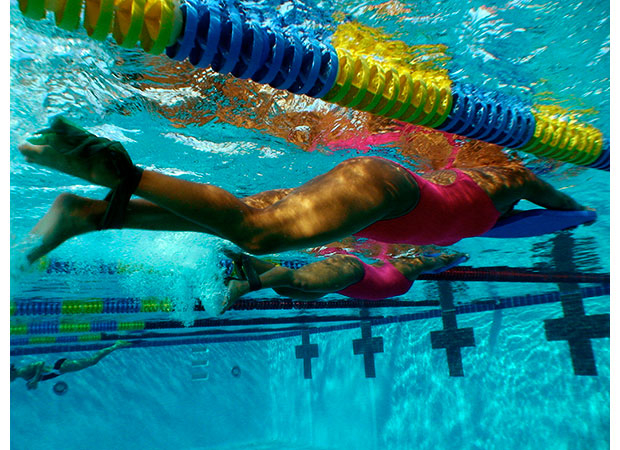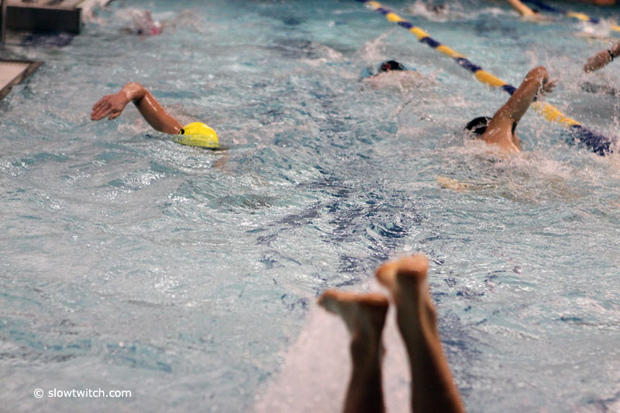Swimming Isn’t Intuitive

Back in 2004 I wrote an article titled The High Cost of Good Form. My thesis runs contrary to what a lot of coaches say, depending on the sport. There’s a view – of which I’m skeptical – that you shouldn’t coach running technique; that everyone will find his or her best run form if they just run enough. We’ll agree to disagree on that.
But some sports are not like running, and swimming is the best example I can think of. There just is nothing intuitive about swimming. Good swim form requires not just knowing how to swim efficiently, but developing the capacity to perform that technique. What makes swimming maddening, frustrating, is that the adoption of good technique doesn’t translate to faster swim times until those muscles develop. Compare that to a grunt sport like cycling, where the best position (at least on a road race bike) is almost always the most powerful position. If you make a change in, say, saddle height a positive change should mean more power to the pedals. it might take weeks for a change in swim technique to pay a speed dividend.
What is it about freestyle that’s unintuitive? Well, freestyle for one thing. Just the whole stroke. The “front crawl” is about 180 years old, as practiced in the European world. Imagine that. Homo Sapiens is millions of years old, but we only figured out the most efficient way to propel ourselves in the medium that covers the globe in the last several generations. (West Africans were performing the front crawl for centuries prior to Europeans and White Americans, but that’s another story.)
So that’s the point. If it was intuitive, we’d have been doing the front crawl for a lot longer than we have. It’s not intuitive. The dog paddle is intuitive. Flailing is intuitive. The front crawl is taught and it makes no sense to stop there and say, “Once you’re taught the basics of the front crawl it, like running, is something that’ll eventually come naturally to you.”
We interviewed Alex Kostich a couple of years ago and below is one image accompanying that interview. He, like our sport’s own Gerry Rodrigues, remain overwhelmingly smart, classy open water swimmers even in the second half of their lifetimes. In this image below note the bent elbow, the pulling surface perpendicular to the medium through which he’s traveling and, hardest of all, the hand near the surface of the water during the extend phase (your hand drifts down after the catch; Alex’s doesn’t).

There’s a longtime triathlon coach, Marty Gaal, and here’s a link to a page. Just look at the still images of the front crawl on that page. This is learned. This is the front crawl optimized. This is hard. Nothing prepares you for this. Well, a Vasa ergomenter, or perhaps even just elastic bands with hand paddles, can help you develop the muscles, if you perform the exercise correctly. But I can’t think of a dryland task that uses the muscles you use in optimized front crawl. What about any of that looks like any act we perform in our daily lives?
For this reason, swimming for you and me consists of drills where you do it the right way, and then a lot of bulk swimming where you’re trying to do it the right way but in large part failing because we just don’t quite have the muscles. This is why most of the Guppy Challenge consists of repeat 50s, 100s, 200s, with rest in between. We perform drills like 6KSwitch, Catch-up, we pull, we bind our ankles, because from the core to the shoulders we’re working the rotator cuff, triceps, lats in ways they’re never used in any other activity and they’re too weak when we first begin. It takes months to build them up. So, we swim, we rest, we swim again, and the reason isn’t simply fitness; it’s because we’re not strong enough to perform that technique properly for a very long distance, until we've built those muscles up. Developing those muscles through repetition and rest is the high cost we pay to achieve good form.
I used the term "classy" to describe a couple of swimmers a bit higher up. There’s a saying in sport: Form is temporary, class is permanent. Form in this case describes fitness. Class describes technique. Once proper front crawl technique becomes a set of motor skills that sits on your brain stem, you have class. You can take a month or two off of swimming and the speed will come back more quickly, because the class is there. The image of Jordan Rapp, highest above, is of an ex-pro triathlete who started his athletic life as a lacrosse player and a rower. Class is achievable.
This week’s Guppy Challenge workouts are on the same Google Sheet as are all the other weeks’ workouts.
If you want to do a 4th swim this week, here’s what I did this morning:
• 12 x 50yd warmup, leaving on an interval that gave me 10 to 15sec rest.
• 50yd kicking
• 8 x 75yd, a little more rest, a little harder.
• 50yd kicking
• 3 x 100yd, a little harder, take about 30sec rest between each.
• 50yd kicking
• 1 x 300yd, not hard, just steady
• 50yd kicking
2000yd total.
The Guppy Challenge Series, in partnership with FORM goggles, thus far:
Text for Guppy Challenge Week 1; Workouts for Week 1
Text for Guppy Challenge Week 2; Workouts for Week 2
Text for Guppy Challenge Week 3; Workouts for Week 3
Text for Guppy Challenge Week 4; Workouts for Week 4
Text for Guppy Challenge Week 5; Workouts for Week 5
Text for Guppy Challenge Week 6; Workouts for Week 6




